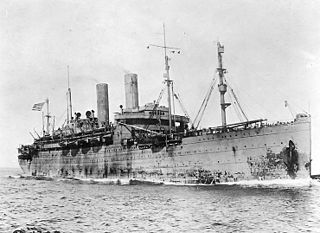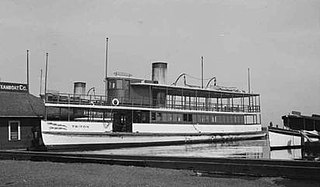The list of ship commissionings in 1909 includes a chronological list of all ships commissioned in 1909.
The list of ship commissionings in 1909 includes a chronological list of all ships commissioned in 1909.
| Ship events in 1909 | |||||||||||
| Ship launches: | 1904 | 1905 | 1906 | 1907 | 1908 | 1909 | 1910 | 1911 | 1912 | 1913 | 1914 |
| Ship commissionings: | 1904 | 1905 | 1906 | 1907 | 1908 | 1909 | 1910 | 1911 | 1912 | 1913 | 1914 |
| Ship decommissionings: | 1904 | 1905 | 1906 | 1907 | 1908 | 1909 | 1910 | 1911 | 1912 | 1913 | 1914 |
| Shipwrecks: | 1904 | 1905 | 1906 | 1907 | 1908 | 1909 | 1910 | 1911 | 1912 | 1913 | 1914 |

An aircraft carrier is a warship that serves as a seagoing airbase, equipped with a full-length flight deck and facilities for carrying, arming, deploying, and recovering aircraft. Typically, it is the capital ship of a fleet, as it allows a naval force to project air power worldwide without depending on local bases for staging aircraft operations. Carriers have evolved since their inception in the early twentieth century from wooden vessels used to deploy balloons to nuclear-powered warships that carry numerous fighters, strike aircraft, helicopters, and other types of aircraft. While heavier aircraft such as fixed-wing gunships and bombers have been launched from aircraft carriers, but these aircraft have not successfully landed on a carrier. By its diplomatic and tactical power, its mobility, its autonomy and the variety of its means, the aircraft carrier is often the centerpiece of modern combat fleets. Tactically or even strategically, it replaced the battleship in the role of flagship of a fleet. One of its great advantages is that, by sailing in international waters, it does not interfere with any territorial sovereignty and thus obviates the need for overflight authorizations from third-party countries, reduces the times and transit distances of aircraft and therefore significantly increase the time of availability on the combat zone.

The fifth USS Enterprise, a barque-rigged screw sloop, was launched 13 June 1874 at Portsmouth Navy Yard, Kittery, Maine, US, by John W. Griffiths, a private contractor; and commissioned 16 March 1877, Commander George C. Remey in command. She was later commanded by Bowman H. McCalla around 1890, followed by Commander Albert S. Barker from 1892 to 1896.

The British Royal Navy's ironclad Admiral-class battleships of the 1880s followed the pattern of the Devastation class in having the main armament on centreline mounts fore and aft of the superstructure. This pattern was followed by most following British designs until HMS Dreadnought in 1906. They were known as the Admiral class because they were all named after British admirals, such as Admiral George Anson.

The first USS Solace (AH-2) was a hospital ship in the United States Navy.

HMS Prince of Wales was one of six 121-gun screw-propelled first-rate three-decker line-of-battle ships of the Royal Navy. She was launched on 25 January 1860.

HMSGannet is a Royal Navy Doterel-class screw sloop-of-war launched on 31 August 1878. She became a training ship in the Thames in 1903, and was then loaned as a training ship for boys in the Hamble from 1913. She was restored in 1987 and is now part of the UK's National Historic Fleet.

USS Tingey (TB-34), was a Blakely-class torpedo boat of the United States Navy. She was the first of three ships to be named after Commodore Thomas Tingey.

SS George Washington was an ocean liner built in 1908 for the Bremen-based North German Lloyd and was named after George Washington, the first President of the United States. The ship was also known as USS George Washington (ID-3018) and USAT George Washington in service of the United States Navy and United States Army, respectively, during World War I. In the interwar period, she reverted to her original name of SS George Washington. During World War II, the ship was known as both USAT George Washington and, briefly, as USS Catlin (AP-19), in a short, second stint in the U.S. Navy.

The first USS Du Pont was launched 30 March 1897 by Herreshoff Manufacturing Co., Bristol, R.I.; sponsored by Miss L. Converse; and commissioned 23 September 1897, Lieutenant Spencer S. Wood in command.

USS Nicholson (TB-29) was a Blakely-class torpedo boat in the United States Navy.

The C-class submarines were five United States Navy submarines built by the Fore River Shipbuilding Company in Quincy, Massachusetts, under a subcontract from the Electric Boat Company. Built between 1906 and 1909, and in commission from 1908 to 1919, all five were subsequently sold for scrap in 1920. They were considerably larger than the preceding B class at 275 tons submerged vs. 173 tons submerged, and were the first United States submarines with two-shaft propulsion, doubling the machinery of the B class.

Pamiat Azova was a unique armoured cruiser built for the Imperial Russian Navy in the late 1880s. She was decommissioned from front line service in 1909, converted into a depot ship and sunk by British torpedo boats during the Baltic Naval War, part of the Russian Civil War.

HMS Ramillies was a Royal Sovereign-class pre-dreadnought battleship of the Royal Navy, named after the Battle of Ramillies. The ship was built by J. & G. Thompson at Clydebank, starting with her keel laying in August 1890. She was launched in March 1892 and commissioned into the Mediterranean Fleet as flagship the following October. She was armed with a main battery of four 13.5-inch guns and a secondary battery of ten 6-inch guns. The ship had a top speed of 16.5 knots.

The steamboat Triton was a passenger ferry that operated on Lake Washington in the first part of the 20th century.

The BL 4-inch gun Mk VII was a British high-velocity naval gun introduced in 1908 as an anti-torpedo boat gun in large ships, and in the main armament of smaller ships. Of the 600 produced, 482 were still available in 1939 for use as coastal artillery and as a defensive weapon on Defensively Equipped Merchant Ships (DEMS) during the Second World War.

HMAS Mallina was a 3,213 GRT cargo ship built by Harland & Wolff, Belfast in 1909 as Mallina for the Australian United Steam Navigation Company for the Rockhampton to Sydney cargo route. She was requisitioned by the Royal Australian Navy in 1914, as a store carrier and collier. She was returned to her owners in 1915. She was sold in 1935 to Machida Shokai Kisen Kaisha, Japan and renamed Seiko Maru, before being sold to Kita Nippon Kisen Kaisha and renamed Siberia Maru No. 3, which was later shortened to Siberian Maru. While steaming in the Sulu Sea, Philippines on 24 September 1944, she was attacked by American aircraft of Task Force 38 and sunk with the loss of 158 of the 2,382 people on board.
HMS Rother was a Palmer type River-class destroyer ordered by the Royal Navy under the 1902–1903 Naval Estimates. Named after the River Rother, east of Sheffield, South Yorkshire in England, she was the first ship to carry this name in the Royal Navy.